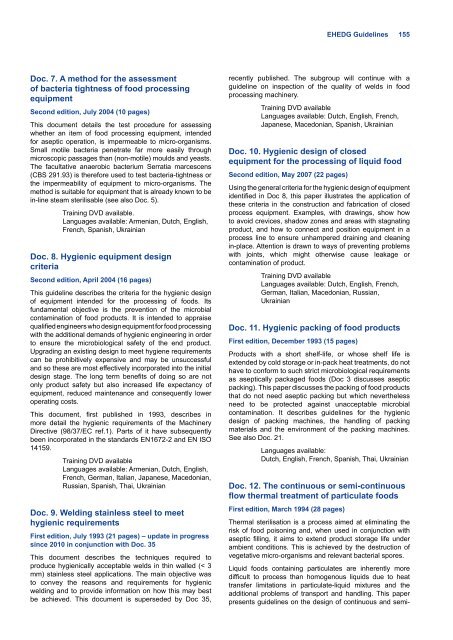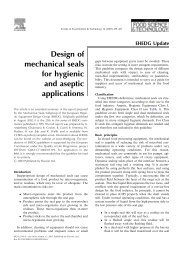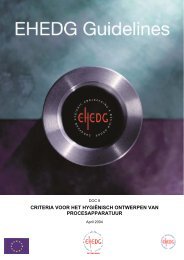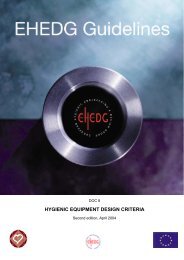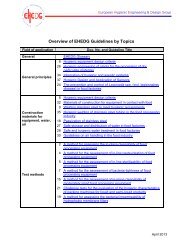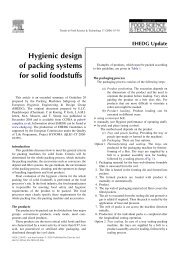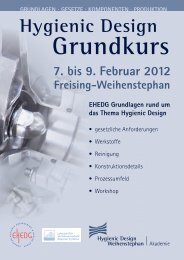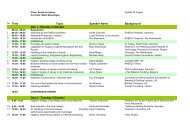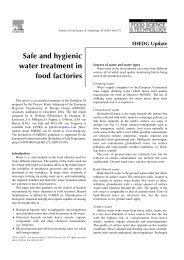Yearbook 2013/2014 - ehedg
Yearbook 2013/2014 - ehedg
Yearbook 2013/2014 - ehedg
Create successful ePaper yourself
Turn your PDF publications into a flip-book with our unique Google optimized e-Paper software.
EHEDG Guidelines 155<br />
Doc. 7. A method for the assessment<br />
of bacteria tightness of food processing<br />
equipment<br />
Second edition, July 2004 (10 pages)<br />
This document details the test procedure for assessing<br />
whether an item of food processing equipment, intended<br />
for aseptic operation, is impermeable to micro-organisms.<br />
Small motile bacteria penetrate far more easily through<br />
microscopic passages than (non-motile) moulds and yeasts.<br />
The facultative anaerobic bacterium Serratia marcescens<br />
(CBS 291.93) is therefore used to test bacteria-tightness or<br />
the impermeability of equipment to micro-organisms. The<br />
method is suitable for equipment that is already known to be<br />
in-line steam sterilisable (see also Doc. 5).<br />
Training DVD available.<br />
Languages available: Armenian, Dutch, English,<br />
French, Spanish, Ukrainian<br />
Doc. 8. Hygienic equipment design<br />
criteria<br />
Second edition, April 2004 (16 pages)<br />
This guideline describes the criteria for the hygienic design<br />
of equipment intended for the processing of foods. Its<br />
fundamental objective is the prevention of the microbial<br />
contamination of food products. It is intended to appraise<br />
qualified engineers who design equipment for food processing<br />
with the additional demands of hygienic engineering in order<br />
to ensure the microbiological safety of the end product.<br />
Upgrading an existing design to meet hygiene requirements<br />
can be prohibitively expensive and may be unsuccessful<br />
and so these are most effectively incorporated into the initial<br />
design stage. The long term benefits of doing so are not<br />
only product safety but also increased life expectancy of<br />
equipment, reduced maintenance and consequently lower<br />
operating costs.<br />
This document, first published in 1993, describes in<br />
more detail the hygienic requirements of the Machinery<br />
Directive (98/37/EC ref.1). Parts of it have subsequently<br />
been incorporated in the standards EN1672-2 and EN ISO<br />
14159.<br />
Training DVD available<br />
Languages available: Armenian, Dutch, English,<br />
French, German, Italian, Japanese, Macedonian,<br />
Russian, Spanish, Thai, Ukrainian<br />
Doc. 9. Welding stainless steel to meet<br />
hygienic requirements<br />
First edition, July 1993 (21 pages) – update in progress<br />
since 2010 in conjunction with Doc. 35<br />
This document describes the techniques required to<br />
produce hygienically acceptable welds in thin walled (< 3<br />
mm) stainless steel applications. The main objective was<br />
to convey the reasons and requirements for hygienic<br />
welding and to provide information on how this may best<br />
be achieved. This document is superseded by Doc 35,<br />
recently published. The subgroup will continue with a<br />
guideline on inspection of the quality of welds in food<br />
processing machinery.<br />
Training DVD available<br />
Languages available: Dutch, English, French,<br />
Japanese, Macedonian, Spanish, Ukrainian<br />
Doc. 10. Hygienic design of closed<br />
equipment for the processing of liquid food<br />
Second edition, May 2007 (22 pages)<br />
Using the general criteria for the hygienic design of equipment<br />
identified in Doc 8, this paper illustrates the application of<br />
these criteria in the construction and fabrication of closed<br />
process equipment. Examples, with drawings, show how<br />
to avoid crevices, shadow zones and areas with stagnating<br />
product, and how to connect and position equipment in a<br />
process line to ensure unhampered draining and cleaning<br />
in-place. Attention is drawn to ways of preventing problems<br />
with joints, which might otherwise cause leakage or<br />
contamination of product.<br />
Training DVD available<br />
Languages available: Dutch, English, French,<br />
German, Italian, Macedonian, Russian,<br />
Ukrainian<br />
Doc. 11. Hygienic packing of food products<br />
First edition, December 1993 (15 pages)<br />
Products with a short shelf-life, or whose shelf life is<br />
extended by cold storage or in-pack heat treatments, do not<br />
have to conform to such strict microbiological requirements<br />
as aseptically packaged foods (Doc 3 discusses aseptic<br />
packing). This paper discusses the packing of food products<br />
that do not need aseptic packing but which nevertheless<br />
need to be protected against unacceptable microbial<br />
contamination. It describes guidelines for the hygienic<br />
design of packing machines, the handling of packing<br />
materials and the environment of the packing machines.<br />
See also Doc. 21.<br />
Languages available:<br />
Dutch, English, French, Spanish, Thai, Ukrainian<br />
Doc. 12. The continuous or semi-continuous<br />
flow thermal treatment of particulate foods<br />
First edition, March 1994 (28 pages)<br />
Thermal sterilisation is a process aimed at eliminating the<br />
risk of food poisoning and, when used in conjunction with<br />
aseptic filling, it aims to extend product storage life under<br />
ambient conditions. This is achieved by the destruction of<br />
vegetative micro-organisms and relevant bacterial spores.<br />
Liquid foods containing particulates are inherently more<br />
difficult to process than homogenous liquids due to heat<br />
transfer limitations in particulate-liquid mixtures and the<br />
additional problems of transport and handling. This paper<br />
presents guidelines on the design of continuous and semi-


